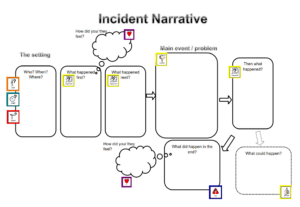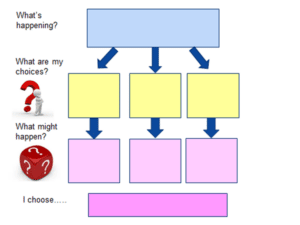Contents
Support for the autistic child when they are the victim of bullying:
School should be a place to make new friends, try new things and grow in confidence. But sadly, we know that many autistic children and young people experience bullying during their time in education.
According to a recent survey by Ambitious about Autism’s Youth Council, 75% of autistic young people have experienced bullying and only half of young people said they felt safe at school.
Some of the following strategies may be helpful:
- Help the child to understand the mindset of the bully. A useful book for teenagers is Emily Lovegrove’s ‘Autism, Bullying and Me’ Chapter 5 ‘Why are other people so awful?’
- For younger children, a social story explaining that adults are helping the bully to be kind, may be useful.
- Create a visual for the child which explains the team around them, of people who can help.
- Create a visual scale, indicating when the child should report a behaviour and when it is OK to shrug it off. The following frame may be helpful:
| Scale | Behaviour | Actions – use examples which are specific to the child | Example words and phrases |
| 5 | Physically harmful or threatening behaviour | ||
| 4 | Verbally harmful or threatening behaviour | ||
| 3 | Teasing and banter | ||
| 2 | Reasonable behaviour | ||
| 1 | Friendly behaviour |
- Teach self-advocacy skills. This could include creating opportunities to script and practice responses and seek help.
- Use Comic Strip Conversations™ to unpick incidents and explore responses. It may help to initially use this strategy with positive situations.
- Explicitly teach understanding of sarcasm and banter using examples relevant to the pupil. Amy Elefthriades’ Social Survival, P42-56 might be helpful
- Review provision and support during unstructured times of day.
- Encourage involvement in a lunchtime club, this may help the young person to develop meaningful friendships, especially where the club is linked to an area of strength or interest.
- Sometimes a young person can perceive others’ behaviour as bullying and may need to be taught to distinguish between bullying, and accidents or misunderstandings. Autistic pupils may benefit from structured social knowledge lessons to help them to navigate different social situations.
The table below from the NAS website, shows the difference between bullying and accidents/misunderstandings:
| Bullying | Accidents or misunderstandings |
| Someone thinks it’s fun to upset you. They say things again and again and laugh when you get cross or sad. | Someone says something that they didn’t know would upset you and they say sorry. they are sad you are upset. |
| They carry on when you ask them to stop. | They stop if you ask them to. |
| They take your things in order to see you get upset. | They borrow something without asking but give it back when you ask. |
| They kick, push, punch or hurt you on purpose. | They accidentally bump into you or push past and then say sorry. |
| They mock things you say or call you names if you make a mistake. | They don’t agree with everything you say but respect your opinion. |
| They send nasty messages to your phone or email. | |
| They ask you to do something that makes you look silly or might get you into trouble. |
List of useful reading resources
List of useful reading and resources:
- Emily Lovegrove: Autism, Bullying and Me
- Carol Gray: The New Social Story Book (Ch7),
- Alex Kelly and Brian Sains: Talkabout for Teenagers (Level 4, p125 – p180)
- Amy Elefthriades: Social Survival (p40 – 42, p49, p56)
- Kari Dunn Buron: 5 is against the Law
NAS bullying and autistic spectrum disorders, a guide for school staff Bullying and autism spectrum disorders a guide for school staff.pdf
There are times when the autistic child might be the bully:
- Consider the link between language needs and behaviour. The SEMH/SLCN Graduated Response Tool and this language checklist will be a useful starting points.
- Use a visual incident narrative. This resource will be supportive of language needs, allowing a child to sequence events and reflect upon what has happened.

- A visual Flow Chart (below) would also be helpful to the child to demonstrate the impact of their behaviour and potential consequences, at the same time as highlighting other behaviour choices they could make.

- Pupils with C&I needs should be given opportunities to practise appropriate ways of engaging with others for example by modelling how to initiate peer interactions.
- Create a visual guide, with example on what are acceptable and unacceptable ways of interacting with peers.
- Pupils will need support to understand how their behaviour can affect others. This could be done through using a Social Story, for example:
Social Story:
- There are social rules which we all should try to live by.
- These social rules keep everybody’s’ feelings safe.
- When social rules are broken, peoples’ feelings are hurt; they might also feel unhappy and unsafe.
- There are sometimes consequences to social rules being broken.
- It can help if we learn about the different levels of behaviour.
- It is important to understand how you feel about different behaviour and how other people might feel about it as well.
- Consequences should always be pre-determined and explained clearly to the pupil with an ASC in advance. They should be fair, consistent and appropriate to the pupil’s understanding.
- Specific acts of appropriate interaction should be reinforced through praise, a reward system. Tell them when they are getting it right!
- Teach scaling strategies to support emotional regulation. It is important for a child to understand that negative feelings are normal, but that it is how we respond to them which is important.
- Explicitly teach understanding of sarcasm and teenage talk, using examples relevant to the pupil.
Please see separate one minute guide for advice and support about online and cyber bullying.